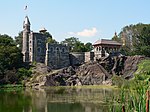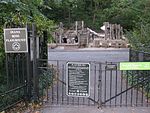Delacorte Theater
1962 establishments in New York CityCentral ParkOutdoor theatresTheatres completed in 1962Theatres in Manhattan ... and 1 more
Use mdy dates from April 2021

The Delacorte Theater is a 1,800-seat open-air theater in Central Park, in the New York City borough of Manhattan. It is home to the Public Theater's free Shakespeare in the Park productions. Over five million people have attended more than 150 free productions of Shakespeare and other classical works and musicals at the Delacorte Theater since its opening in 1962.
Excerpt from the Wikipedia article Delacorte Theater (License: CC BY-SA 3.0, Authors, Images).Delacorte Theater
West Drive, New York Manhattan
Geographical coordinates (GPS) Address Website External links Nearby Places Show on map
Geographical coordinates (GPS)
| Latitude | Longitude |
|---|---|
| N 40.7801 ° | E -73.968766666667 ° |
Address
Delacorte Theater
West Drive
10024 New York, Manhattan
New York, United States
Open on Google Maps










